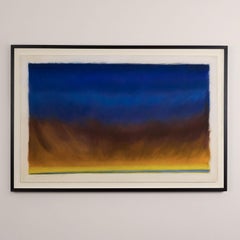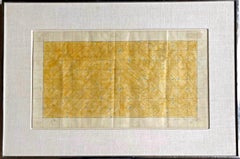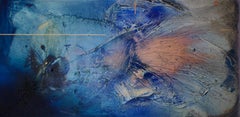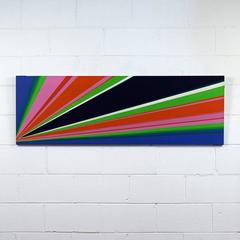Rita Letendre Paintings
to
1
Overall Width
to
Overall Height
to
1
1
1
1
1
6
784
712
707
702
1
Artist: Rita Letendre
Brahms and the Twilight
By Rita Letendre
Located in Toronto, Ontario
Rita Letendre (b.1928) is one of Canada’s leading female abstract painters.
While Letendre was associated with Les Automatistes in Montreal (which included Borduas, and Riopelle am...
Category
1980s Color-Field Rita Letendre Paintings
Materials
Pastel
Related Items
Larry Poons, Midget Racer, unique Color Field Abstract Geometric drawing, signed
By Larry Poons
Located in New York, NY
Larry Poons
Midget Racer, 1963
Colored Pencil on Graph Paper
Signed, titled, and dated by the artist on the lower right front
Original frame with gallery label included
Provenance: H...
Category
1960s Color-Field Rita Letendre Paintings
Materials
Mixed Media, Color Pencil
$20,000
H 16.5 in W 24.5 in D 1 in
At sea between fossils and satellites 7 (blue organic copper abstract texture)
By Melisa Taylor Metzger
Located in Quebec, Quebec
"At Sea between Fossils and Satellites 7" is a textural and elemental abstract painting on canvas. It explores the hybridization of chance-derived color-fields with art deco aestheti...
Category
2010s Color-Field Rita Letendre Paintings
Materials
Acrylic Polymer, Found Objects, Oil, Acrylic
$5,000
H 30 in W 60 in D 1 in
from the smoke and ash - Abstract tantric stain painting, acrylic on raw canvas
Located in Philadelphia, PA
from the smoke and ash - Abstract tantric stain painting, acrylic on raw canvas by contemporary artist Elisa Niva33 inches x 29 inches.
One of the main i...
Category
2010s Color-Field Rita Letendre Paintings
Materials
Cotton Canvas, Acrylic
$399 Sale Price
71% Off
H 33 in W 29 in D 0.88 in
Battle of the Sexes, Mathematical Conceptual Abstraction, Science Art Collection
By Anastasia Vasilyeva
Located in Zofingen, AG
This artwork was made in the Colorfield concept with the character elements - the formulas on the painting are from mathematical game theory.
In game theory, the battle of the sexes...
Category
2010s Color-Field Rita Letendre Paintings
Materials
Canvas, Oil Pastel, Acrylic
$1,793
H 47.25 in W 31.5 in D 0.71 in
Modernist Gestural Abstract Color Field Painting Woman Artist Francine Tint
By Francine Tint
Located in Surfside, FL
Francine Tint (b. 1943)
Another Time
Thick acrylic impasto on board, 1999,
Hand signed 'Francine Tint' titled, dated
Inscribed 'To Piri, Enjoy Much Love' on the reverse.
14 x 15 1/...
Category
1990s Color-Field Rita Letendre Paintings
Materials
Acrylic, Acrylic Polymer, Wood Panel
Holi powder Tantra painting #4 - Colorful abstract tantric stain painting
Located in Philadelphia, PA
Holi powder Tantra painting #4 - Colorful abstract tantric stain painting, acrylic and powder on raw canvas by contemporary artist Elisa Niva 42 inche...
Category
2010s Color-Field Rita Letendre Paintings
Materials
Cotton Canvas, Acrylic
$504 Sale Price
36% Off
H 42 in W 32 in D 1.5 in
Water Shine
By Ira Barkoff
Located in Greenwich, CT
Born in 1934 in Brooklyn, New York, Ira Barkoff’s paintings feature empty, Zen-like landscapes whose stillness reflects a location’s essence. Barkoff seeks to “portray a sense of vas...
Category
2010s Color-Field Rita Letendre Paintings
Materials
Canvas, Oil
Dexter's Choice State II, signed mixed media watercolor (unique variant), Framed
By Larry Zox
Located in New York, NY
Larry Zox
Dexter's Choice, State II, ca. 1990
Mixed media, Watercolor pochoir, and Oil stick Wax, Water-Based Crayons, on heavy Arches museum watercolor rag paper with deckled edges
...
Category
1990s Color-Field Rita Letendre Paintings
Materials
Crayon, Mixed Media, Oil, Watercolor, Graphite, Monoprint
$10,000
H 42 in W 62 in D 1.5 in
Mid Century Textural Color-Field Abstract in Royal Blue-Purple by Peter Witwer
By Peter Witwer
Located in Soquel, CA
Mid Century Textural Color-Field Abstract in Royal Blue-Purple by Peter Witwer
A striking mid-century textural color-field abstract in a bold color palette of royal blue-purple by San Francisco artist Peter Witwer (American, 1928-1968). This highly textured mixed media piece, c.1960's, uses a monochromatic palette that is divided into two areas of varying textural depths. The lower part of the canvas verges on sculptural, as the textured surface becomes almost three-dimensional and haunting forms emerge from the abstract purple-blue plane.
Unsigned. From a collection of the artist's works.
Displayed in a painted wood slate frame. Frame has been painted by the artist and is considered part of the artwork.
Linen size: 26"H x 22"W.
Framed size: 27"H x 23"W x 1.2"D
Unsigned, but was acquired with a collection of the artist's work.
Provenance: Without a will and a family that had little interest in his art, nearly all of his possessions and close to 100 paintings were turned over to SF’s Conservators Office. His friend, Albert Richard Lasker, purchased all of Peter’s possessions (including the art) and has taken care of them until this day, always sensing there was something remarkable about the collection. Wanting Peter’s work to finally be seen, Richard came to Lost Art Salon with Peter’s story after reading about the new gallery in a July, 2005 issue of the SF Chronicle.
Born George Peter...
Category
1960s Color-Field Rita Letendre Paintings
Materials
Linen, Oil, Mixed Media
$1,170 Sale Price
35% Off
H 27 in W 23 in D 1.2 in
At sea between fossils and satellites 7 (blue organic copper abstract texture)
By Melisa Taylor Metzger
Located in Quebec, Quebec
"At Sea between Fossils and Satellites 7" is a textural and elemental abstract painting on canvas. It explores the hybridization of chance-derived color-fields with art deco aestheti...
Category
2010s Color-Field Rita Letendre Paintings
Materials
Acrylic Polymer, Found Objects, Oil, Acrylic
$5,000
H 60 in W 30 in D 1 in
Pink Geometric Altar Diptych, Surreal Landscape, Modern Monument Architecture
By Natalia Roman
Located in Barcelona, ES
These series of paintings by Natalia Roman gather their inspiration from geometric, minimalist shapes and paintings from the beginning of Modernism, with a special emphasis on Art De...
Category
2010s Color-Field Rita Letendre Paintings
Materials
Acrylic, Archival Paper
$536 Sale Price
33% Off
H 28 in W 40 in
Blue and Green Abstract
By Claudia Sisemore
Located in Salt Lake City, UT
"Blue and Green Abstract" by Claudia Sisemore, acylic on canvas, 43.5 x 46 inches, $4,800.
"I have a vague idea of what I am going to paint. I...
Category
1970s Color-Field Rita Letendre Paintings
Materials
Canvas, Acrylic
Previously Available Items
Sina
By Rita Letendre
Located in Toronto, Ontario
Rita Letendre (b.1928) is one of Canada’s leading female abstract painters...and one of Caviar20's favorite artists.
While Letendre was in...
Category
1970s Abstract Rita Letendre Paintings
Materials
Acrylic
Rita Letendre paintings for sale on 1stDibs.
Find a wide variety of authentic Rita Letendre paintings available for sale on 1stDibs. You can also browse by medium to find art by Rita Letendre in crayon, pastel and more. Not every interior allows for large Rita Letendre paintings, so small editions measuring 40 inches across are available. Customers who are interested in this artist might also find the work of Martin Canin, Mala Breuer, and Michael David. Rita Letendre paintings prices can differ depending upon medium, time period and other attributes. On 1stDibs, the price for these items starts at $14,500 and tops out at $14,500, while the average work can sell for $14,500.



